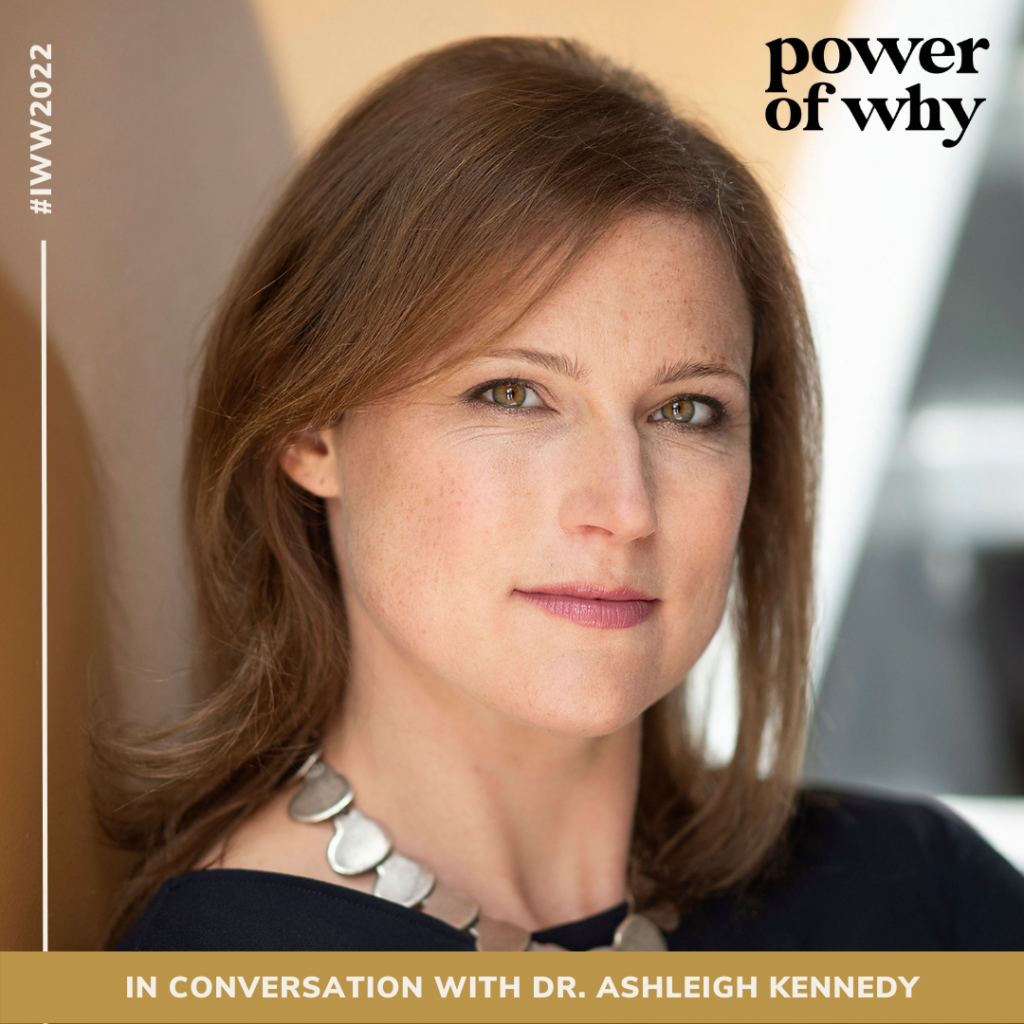Home » The Ethics of Artificial Intelligence and Healthcare With Dr. Ashleigh Kennedy
The Ethics of Artificial Intelligence and Healthcare With Dr. Ashleigh Kennedy

Mar 3, 2022
 This featured story is brought to you by the Power of Why Podcast in collaboration with Invest Ottawa. We teamed up to produce this special series to celebrate women leading in Ottawa for International Women’s Week (IWW 2022) and shine the spotlight on our IWW 2022 featured leaders to unpack their passion and purpose.
This featured story is brought to you by the Power of Why Podcast in collaboration with Invest Ottawa. We teamed up to produce this special series to celebrate women leading in Ottawa for International Women’s Week (IWW 2022) and shine the spotlight on our IWW 2022 featured leaders to unpack their passion and purpose.
Each year, five inspirational leaders are selected to represent International Women’s Week. They are role models achieving a significant impact on our economy, community and society, and embody the spirit, goals and values of IWW.
Touching the most complex organ in the human body, concussion treatment continues to evolve as experts learn more about the workings of our brain—to mitigate the debilitating, long-term consequences of mistreatment.
That’s why Dr. Ashleigh Kennedy co-founded health-tech startup Neurovine AI: combining deep tech, machine learning and the art of neuroscience to empower concussion patients and optimize their recovery process.
Ashleigh joined us to share how she co-founded Neurovine from personal experience and professional need, why a values-based business is key to securing top talent, what it’ll take the health sector to adopt new tech, and how modern concussion treatment is helping patients do more than recover, to thrive.
This episode is for you if:
- You’re building a health-tech startup
- You want to know the treatments that can help you, or someone you love, overcome their concussion
- You have concerns about the ethical implications of introducing AI to healthcare
- You want to know what it’ll take for the health sector to embrace new technologies
Listen to the episode on Spotify / iTunes / Google Podcasts / Castbox
Tune in to the podcast or take the time to digest each article found below. Regardless the format, there is stellar content in store for you!
Naomi: Tell us about your origin story.
Ashleigh: I grew up in a family of athletes. My sister was Canada’s 2006 Olympics team captain for gymnastics in 2006. She suffered a major concussion before her performance and still competed, but was so disoriented she didn’t know where to start her routine.
For years, people have just dealt with brain injuries like it’s a badge of honor, or a weakness to acknowledge its impact.
My dad played professional football and he lost a friend to suicide. He was open about the mental health struggles his friend had after retiring from football. A lot of players struggle with concussions.
This drove me to study human performance in neuroscience. I ran track at Stanford, and built my first EEG headband as a freshman. I was part of a research team and a Stanford professor tasked us, a group of students, to do it.
When you’re thrown into a situation, and people expect you to define the answer, I think that’s exhilarating. That was my first step into entrepreneurship, without really even knowing it.
I have a PhD in exercise physiology from the University of Nantes in France, a PhD in Motor Control and Neuroscience from the University of Ottawa, and was a postdoc at the Toronto Rehab Institute.
Rehabilitation institutes are pushing the boundary, allowing the adoption of next generation technologies into the standard of practice. I worked on projects where wearable technologies were deployed and saw the impact on patients’ physical health and emotional well-being, as well as that of their care circles.
These families, or caregivers, felt like there was a clear roadmap through the recovery journey, where they could be part of it, because of this integration of technology into their healthcare.
My co-founder, who’s my husband, is a family physician. He inherited a family medicine practice that had a lot of long-term concussion patients, and he felt like he didn’t have the data to support their care journey. He pushed us off the cliff to build something that can put patients in the driver’s seat.
Over the past three years, that blossomed into this AI-driven platform. We’ve added young, brilliant people to our mission, largely because of their own personal experience with brain injury.
Talent joins us because of the mission-driven and value-based approach we’re taking to healthcare.
Naomi: What is a concussion, and what are possible long-term consequences of the repetitive concussive hits many athletes face?
Ashleigh: The brain is soft, encased in fluid, with a protective skull around it. A concussion is caused by your brain hitting the skull and bruising. It doesn’t have to be a direct hit, it can be the result of severe whiplash.
A concussion can vary from mild to severe. A mild traumatic brain injury is what we define as a concussion. It means we can’t see any of the brain bleed or structural damage on a scan of any sort, such as a CT scan or an MRI. But it’s not necessarily mild.
One of the biggest impacts on the brain is a shearing force on the white matter, the connective tissue underneath the outer gray matter of your brain—it’s like a highway that connects your brain. This shearing interrupts your brain’s communication.
The early acute phase is what we typically think of as a concussion: when you might have some nausea and memory loss, you’re exhausted, you’ve got a bad headache. For most people that subsides within a couple of weeks and they feel like themselves again.
For about 40% of concussive events, underlying symptoms can last much longer. For example, elite athletes, even if they feel like themselves and are cleared to return back to sport, when we look in the laboratory at their functionality, it’s significantly reduced.
These patients continue to have bad balance, or visual neglect where they can’t see objects coming from the side, because that communication between their eyes and their brain is damaged.
Imagine putting a kid back on the field who can’t see somebody running at them from the side. They’re more susceptible to being hit, they can’t brace themselves or move out of the way. This results in repetitive concussions.
These repetitive concussions can lead to a long-term brain disease called chronic traumatic encephalopathy. It’s horrifying. Basically your brain eats itself from the inside out and you are left with a shriveled skeleton of a brain. That impacts mental health, cognitive function.
If we could care for people properly after a concussion to get back to their baseline, we would put healthy people back on the field. One of the biggest challenges for a concussion patient is returning back to cognitive activity, so school or work, caring for young children.
That’s what we’re tackling as a company. How do we provide the tools to support a patient returning back to their cognitive function after a concussion?
Naomi: You talked a bit about personalization, and using wearables to collect data to inform caregivers, physicians – all the people involved in recovery. What opportunities do you see in this space?
Ashleigh: If you’re suffering from a heart condition, physicians can look at data based on a snapshot of that person’s heart health, like through a holter monitor. But wearables tell the rest of the story between those snapshots, giving us a complete holistic look of that person’s health.
That storytelling, for patients who suffered from brain disorders or injuries, doesn’t exist yet. EEG is only one avenue to do this. This tool looks at the electrical activity of the brain, and helps us look at anxiety, depression, and diagnose epilepsy. But it’s only recently that EEG has become a wearable.
It’s been around for 110 years, but before you’d be wired to a big machine with 32 leads and you’d use sandpaper to get a good connection between the lead and the person’s brain.
Naomi: How does your app support the recovery process?
Ashleigh: Our mission at Neurovine is to put the patient in the driver’s seat of their brain health recovery journey, while providing that data to clinicians, so they can make medically informed decisions for their patients.
We have a gamified onboarding process that helps patients tell the whole story about their brain health—combining EEG, heart rate variability, and a whole bunch of other metrics.
Our technology can deliver personalized training programs to support the patient where they are, in the moment. These programs are informed by their clinician, but they continue to learn, so they get more challenging as the patient becomes healthier.
We’re using EEG to get the patient back to work or school, get them back to their cognitive activities and prevent them from over-exerting themselves.
Naomi: When it comes to integrating AI into healthcare, what are some of the challenges around equity and privacy?
Ashleigh: There’s three big reasons why clinicians are not adopting some of these AI driven technologies. One is they’re already really good at their job, so if the technology is not making them better and faster, it’s just annoying.
On top of that, the technology we build has to be transparent, it cannot be a black box that’s making decisions that clinicians don’t understand.
The third is that we need inclusive data from the entire population to deliver algorithms and decision making tools that truly democratize health care. This data driven medicine has the capacity to reduce healthcare costs globally, but if our algorithms are based on the North American population, they’re not going to transfer to other countries.
If we don’t get it right, it’s going to deepen the digital divide between rich countries and some that are developing. It’s going to take collaboration between scientists, clinicians and organizations like the World Health Organization.
Naomi: We’re talking about reducing costs by integrating technologies. Why isn’t this making resources more accessible to everyone that needs them?
Ashleigh: There is a resistance to adopt some of these technologies by clinicians. Some new technologies are first adopted by consumers who can afford it, and bring them to their doctors.
For this process to be equitable, clinicians need to integrate these technologies into their practice first. They need to be incentivized to do that, say through the American Medical Association, or provincially.
We see AI used in other fields where things move faster. But medicine is slow because it’s evidence based, which is great, but it also needs to change.
If industry and academia can show the economic benefit and the evidence for the effectiveness of our solutions, payers will follow – whether that’s provincial, OHIP in Ontario or private payers in the United States.
It’s a slow moving machine, but there’s progress being made both in Canada and the United States.
Naomi: What’s your big vision?
Ashleigh: We live in an age where the consumer is entitled, which I say positively. If I need Ziploc bags, I’m going to order them on Amazon and they’ll be here tomorrow morning. We are used to instant gratification.
We’re starting to see those demands from our healthcare system. And I think that’s right. Patients need to be part of their health journey.
If we could incorporate some behavioral health modifications, delivered through these digital therapeutics that we’re building, to provide patients with what they’re asking for – which is to be part of this journey – we would see a massive decrease in the cost of our health care ecosystem.
We would see people with these chronic diseases thriving. We would see family members and caregivers knowing how to help their loved ones.
We see Neurovine as being the tool that makes brain health visible to patients and their caregivers across a lot of different brain disorders and injuries. I would love to see Neurovine prescribed alongside medication for epilepsy, or supporting patients as they recover from a stroke.
The technology we’re providing is engaging. You can track your progress. You don’t feel like you’re stuck in a rut. You know what’s helping and what’s not. The software system that we’ve built translates nicely into a huge array of brain health disorders.
Naomi: For folks who have, or know a loved one who has had a concussion, what should they look out for when it comes to recovery?
Ashleigh: Historically, we have thought of concussion as this injury that happens, and then you just need to rest until you feel better.
We know now that if you’ve got some sort of clinical oversight to make sure you’re not overdoing it, after a concussion, exercise is medicine.
Concussions can severely impact mental health. New or worsening anxiety and depression are things to keep a pulse on.
Something that’s often overlooked post concussion is the way that your eyes and brain function together. I think that’s probably the symptom that lasts the longest and is most often undetected. I’d encourage you to get your eyes tested.
The final thing I’d add is mindfulness meditation. We’ve got a series on our website you can access for free. When you have a concussion, your brain’s firing on all cylinders all of the time.
If you can practice mindfulness and meditation and get good at it, you can start using your brain more effectively, and not burn through the gas.
Naomi: What’s happening in your industry that you’re keeping your eye on right now?
Ashleigh: Neurovine falls into this digital therapeutics sector. We’re seeing a slow but steady change in pharmaceutical companies, where when you’re prescribed a drug, you’re also prescribed a digital therapeutic, and it’s dose prescribed. You’ll get 150 pills and three months of digital therapeutic intervention.
When those two are married, we’re seeing a much better outcome for the patient.
I’m also interested in seeing what will happen with some of these big guys like Google, Apple, Amazon getting into digital healthcare. They could get it right. They could get it wrong. But there’ll be a huge change in the industry as these big players come in.
Naomi: They are making their way to healthcare because it’s a massive industry. They see the opportunity. What you mentioned about getting it right is very important.
Connect with Dr. Ashleigh Kennedy
About the Power of Why Host, Naomi Haile

An intrapreneur, consultant, and interviewer.
Naomi Haile is curious about people, their paths and what drives them. In 2017, she launched the Power of Why Podcast. Her guests have taken the non-linear path in business, venture capital and other creative professions to share their story. Each episode explores people’s philosophy on life and work.
As we all navigate our lives and careers, Naomi hopes that everyone she connects with – guests and listeners – can shape products, companies, and communities of impact.
Naomi is a consultant at QuakeLab. She is starting graduate school at Columbia University.
In support of its Women Founders and Owners strategy, Invest Ottawa offers programs and services that enable and accelerate the growth and success of women entrepreneurs from every walk of life. Visit www.investottawa.ca/women to learn more!
Invest Ottawa
https://investottawa.ca
Invest Ottawa, is Ottawa’s leading economic development agency for fostering the advancement of the region's globally competitive knowledge-based institutions and industries. Invest Ottawa delivers its economic development services through a unique partnership with the City of Ottawa, where the City and Invest Ottawa, through its members set the strategy and manage the programs that move Ottawa’s economy forward. Invest Ottawa is a non-profit, partnership organization that operates on an annual budget that comes from a variety of sources including: municipal, federal and provincial government; membership fees; professional development programs; and private sector contributions.


